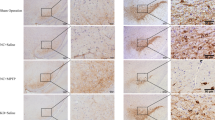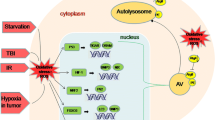Abstract
This study examined whether the cytokine interferon (IFN) gamma plays a role in the injury of SH-SY5Y cells caused by MPP(+) (1-methyl-4-phenylpyridinium). First of all, IFN-gamma sensitized cells to the neurotoxin MPP(+), as determined by MTT (3-(4,5-dimethylthiazol-2-y1)-2,5-diphenyltetrazolium bromide) assay. MPP(+)-injured cells showed higher reactive oxygen species (ROS) levels, which was reinforced by IFN-gamma. The injury triggered a marked expression of the neuronal NOS (nNOS) enzyme. L-NAME [N(ω)-nitro-l-arginine methyl ester, a non-specific NOS inhibitor] reestablished the cell viability after IFN-gamma challenging, and recovered cells from MPP(+) injury (95.0 vs. 84.7 %; P < 0.05). Seven-NI (7-nitroindazole, a nNOS inhibitor) protected cells against the injury by MPP(+) co-administered with IFN-gamma. Both inhibitors restrained the apoptosis of SH-SY5Y cells caused by MPP(+)/IFN-gamma. Regarding oxidative stress, L-NAME and 7-NI attenuated the increase in ROS levels caused by MPP(+) (45.3 or 48.4 vs. 87.9 %, P < 0.05). Indeed, L-NAME was more effective than 7-NI for reducing oxidative stress caused by MPP(+) under IFN-gamma exposition. The nNOS gene silencing by small-interfering RNAs recovered cells challenged by IFN-gamma (24 h), or MPP(+) (8 h). In conclusion, IFN-gamma sensitizes cells to MPP(+)-induced injury, also causing an increase in ROS levels. Pretreating cells with L-NAME or 7-NI reverts both the oxidative stress and apoptosis triggered by the neurotoxin MPP(+). Taking together, our data reinforce that IFN-gamma and NOS enzymes play a role in oxidative stress and dopaminergic cell death triggered by MPP(+).








Similar content being viewed by others
References
Shulman JM, De Jager PL, Feany MB (2011) Parkinson’s disease: genetics and pathogenesis. Annu Rev Pathol 6:193–222. doi:10.1146/annurev-pathol-011110-130242
Jellinger KA (2012) Neuropathology of sporadic Parkinson’s disease: evaluation and changes of concepts. Mov Disord 27(1):8–30. doi:10.1002/mds.23795
Przedborski S (2005) Pathogenesis of nigral cell death in Parkinson’s disease. Parkinsonism Relat Disord 11(Suppl 1):S3–S7. doi:10.1016/j.parkreldis.2004.10.012
Fahn S (2003) Description of Parkinson’s disease as a clinical syndrome. Ann N Y Acad Sci 991:1–14. doi:10.1111/j.1749-6632.2003.tb07458.x
Double KL (2012) Neuronal vulnerability in Parkinson’s disease. Parkinsonism Relat Disord 18(Suppl 1):S52–S54. doi:10.1016/S1353-8020(11)70018-9
Przedborski S (2010) Inflammation and Parkinson’s disease pathogenesis. Mov Disord 25(Suppl 1):S55–S57. doi:10.1002/mds.22638
Hirsch EC, Vyas S, Hunot S (2012) Neuroinflammation in Parkinson’s disease. Parkinsonism Relat Disord 18(Suppl 1):S210–S212. doi:10.1016/S1353-8020(11)70065-7
McGeer P, McGeer EG (2008) Glial reactions in Parkinson’s disease. Mov Disord 23:474–483. doi:10.1002/mds.21751
Teismann P, Tieu K, Cohen O, Choi DK, du Wu C, Marks D, Vila M, Jackson-Lewis V, Przedborski S (2003) Pathogenic role of glial cells in Parkinson’s disease. Mov Disord 18:121–129. doi:10.1002/mds.10332
Tansey MG, Goldberg MS (2010) Neuroinflammation in Parkinson’s disease: its role in neuronal death and implications for therapeutic intervention. Neurobiol Dis 37:510–518. doi:10.1016/j.nbd.2009.11.004
More SV, Kumar H, Kim IS, Song SY, Choi DK (2013) Cellular and molecular mediators of neuroinflammation in the pathogenesis of Parkinson’s disease. Mediat Inflamm 952375. doi:10.1155/2013/952375
Saha B, Jyothi Prasanna S, Chandrasekar B, Nandi D (2010) Gene modulation and immunoregulatory roles of interferon gamma. Cytokine 50(1):1–14. doi:10.1016/j.cyto.2009.11.021
Platanias LC (2005) Mechanisms of type-I- and type-II-interferon-mediated signalling. Nat Rev Immunol 5(5):375–386. doi:10.1038/nri1604
Hirsch EC, Breidert T, Rousselet E, Hunot S, Hartmann A, Michel PP (2003) The role of glial reaction and inflammation in Parkinson’s disease. Ann N Y Acad Sci 991:214–228. doi:10.1111/j.1749-6632.2003.tb07478.x
Gaki GS, Papavassiliou AG (2014). Oxidative stress-induced signaling pathways implicated in the pathogenesis of Parkinson’s disease. Neuromol Med 16(2):217–230. doi:10.1007/s12017-014-8294-x
Moncada S, Bolanos JP (2006) Nitric oxide, cell bioenergetics and neurodegeneration. J Neurochem 97(6):1676–1689. doi:10.1111/j.1471-4159.2006.03988.x
Hara MR, Snyder SH (2007) Cell signaling and neuronal death. Annu Rev Pharmacol Toxicol 47:117–141. doi:10.1146/annurev.pharmtox.47.120505.105311
Schulz JB, Matthews RT, Jenkins BG, Ferrante RJ, Siwek D, Henshaw DR, Cipolloni PB, Mecocci P, Kowall NW, Rosen BR et al (1995) Blockade of neuronal nitric oxide synthase protects against excitotoxicity in vivo. J Neurosci 15(12):8419–8429
Kamijo R, Harada H, Matsuyama T, Bosland M, Gerecitano J, Shapiro D, Le J, Koh SI, Kimura T, Green SJ et al (1994) Requirement for transcription factor IRF-1 in NO synthase induction in macrophages. Science 263(5153):1612–1615
Ebadi M, Sharma SK (2003) Peroxynitrite and mitochondrial dysfunction in the pathogenesis of Parkinson’s disease. Antioxid Redox Signal 5(3):319–335. doi:10.1089/152308603322110896
Hunot S, Boissiere F, Faucheux B, Brugg B, Mouatt-Prigent A, Agid Y, Hirsch EC (1996) Nitric oxide synthase and neuronal vulnerability in Parkinson’s disease. Neuroscience 72(2):355–363
Xie HR, Hu LS, Li GY (2010) SH-SY5Y human neuroblastoma cell line: in vitro cell model of dopaminergic neurons in Parkinson’s disease. Chin Med J 123(8):1086–1092
Presgraves SP, Ahmed T, Borwege S, Joyce JN (2004) Terminally differentiated SH-SY5Y cells provide a model system for studying neuroprotective effects of dopamine agonists. Neurotox Res 5(8):579–598
Cheung YT, Lau WK, Yu MS, Lai CS, Yeung SC, So KF, Chang RC (2009) Effects of all-trans-retinoic acid on human SH-SY5Y neuroblastoma as in vitro model in neurotoxicity research. Neurotoxicology 30(1):127–135. doi:10.1016/j.neuro.2008.11.001
Agholme L, Lindstrom T, Kagedal K, Marcusson J, Hallbeck M (2010) An in vitro model for neuroscience: differentiation of SH-SY5Y cells into cells with morphological and biochemical characteristics of mature neurons. J Alzheimers Dis 20(4):1069–1082. doi:10.3233/JAD-2010-091363
Brzozowski MJ, Alcantara SL, Iravani MM, Rose S, Jenner P (2011) The effect of nNOS inhibitors on toxin-induced cell death in dopaminergic cell lines depends on the extent of enzyme expression. Brain Res 1404:21–30. doi:10.1016/j.brainres.2011.05.063
Vistica DT, Skehan P, Scudiero D, Monks A, Pittman A, Boyd MR (1991) Tetrazolium-based assays for cellular viability: a critical examination of selected parameters affecting formazan production. Cancer Res 51(10):2515–2520
Huesken D, Lange J, Mickanin C, Weiler J, Asselbergs F, Warner J, Meloon B, Engel S, Rosenberg A, Cohen D, Labow M, Reinhardt M, Natt F, Hall J (2005) Design of a genome-wide siRNA library using an artificial neural network. Nat Biotechnol 23(8):995–1001. doi:10.1038/nbt1118
Dotsch J, Harmjanz A, Christiansen H, Hanze J, Lampert F, Rascher W (2000) Gene expression of neuronal nitric oxide synthase and adrenomedullin in human neuroblastoma using real-time PCR. Int J Cancer 88(2):172–175. doi:10.1002/1097-0215
Kwon MJ, Oh E, Lee S, Roh MR, Kim SE, Lee Y, Choi YL, In YH, Park T, Koh SS, Shin YK (2009) Identification of novel reference genes using multiplatform expression data and their validation for quantitative gene expression analysis. PLoS One 4(7):e6162. doi:10.1371/journal.pone.0006162
Livak KJ, Schmittgen TD (2001) Analysis of relative gene expression data using real-time quantitative PCR and the 2(−Delta Delta C(T)) method. Methods 25(4):402–408. doi:10.1006/meth.2001.1262
Calabrese V, Cornelius C, Rizzarelli E, Owen JB, Dinkova-Kostova AT, Butterfield DA (2009) Nitric oxide in cell survival: a janus molecule. Antioxid Redox Signal 11(11):2717–2739. doi:10.1089/ARS.2009.2721
Frank-Cannon TC, Alto LT, McAlpine FE, Tansey MG (2009) Does neuroinflammation fan the flame in neurodegenerative diseases? Mol Neurodegener 16:4–47. doi:10.1186/1750-1326-4-47
Mount MP, Lira A, Grimes D, Smith PD, Faucher S, Slack R, Anisman H, Hayley S, Park DS (2007) Involvement of interferon-gamma in microglial-mediated loss of dopaminergic neurons. J Neurosci 27(12):3328–3337. doi:10.1523/JNEUROSCI.5321-06.2007
Chakrabarty P, Ceballos-Diaz C, Lin WL, Beccard A, Jansen-West K, McFarland NR, Janus C, Dickson D, Das P, Golde TE (2011) Interferon-gamma induces progressive nigrostriatal degeneration and basal ganglia calcification. Nat Neurosci 14(6):694–696. doi:10.1038/nn.2829
Langston JW, Irwin I, Langston EB, Forno LS (1984) 1-Methyl-4-phenylpyridinium ion (MPP+): identification of a metabolite of MPTP, a toxin selective to the substantia nigra. Neurosci Lett 48(1):87–92
Perfeito R, Cunha-Oliveira T, Rego AC (2013) Reprint of: revisiting oxidative stress and mithocondrial disfunction. Free Radic Biol Med 62:186–201. doi:10.1016/j.freeradbiomed.2013.05.042
Przedborski S, Jackson-Lewis V, Yokoyama R, Shibata T, Dawson VL, Dawson TM (1996) Role of neuronal nitric oxide in 1-methyl-4-phenyl-1,2,3,6-tetrahydropyridine (MPTP)-induced dopaminergic neurotoxicity. Proc Natl Acad Sci USA 93:4565–4571
Alberio T, Lopiano L, Fasano M (2012) Cellular models to investigate biochemical pathways in Parkinson’s disease. FEBS J 279:1146–1155. doi:10.1111/j.1742-4658.2012.08516
Sapru MK, Yates JW, Hogan S, Jiang L, Halter J, Bohn MC (2006) Silencing of human alpha-synuclein in vitro and in rat brain using lentiviral-mediated RNAi. Exp Neurol 198(2):382–390. doi:10.1016/j.expneurol.2005.12.024
Zhang QL, Niu Q, Shi YT, Niu PY, Liu CY, Zhang L, Zhang C (2009) Therapeutic potential of BAK gene silencing in aluminum induced neural cell degeneration. J Inorg Biochem 103(11):1514–1520. doi:10.1016/j.jinorgbio.2009.06.010
Zhu Y, Hoell P, Ahlemeyer B, Sure U, Bertalanffy H, Krieglstein J (2007) Implication of PTEN in production of reactive oxygen species and neuronal death in in vitro models of stroke and Parkinson’s disease. Neurochem Int 50(3):507–516. doi:10.1016/j.neuint.2006.10.010
Ortiz-Ortiz MA, Morán JM, González-Polo RA, Niso-Santano M, Soler G, Bravo-San Pedro JM, Fuentes JM (2009) Nitric oxide-mediated toxicity in paraquat-exposed SH-SY5Y cells: a protective role of 7-nitroindazole. Neurotox Res 16(2):160–173. doi:10.1007/s12640-009-9065-6
Madathil KS, Karuppagounder SS, Haobam R, Varghese M, Rajamma U, Mohanakumar KP (2013) Nitric oxide synthase inhibitors protect against rotenone-induced, oxidative stress mediated parkinsonism in rats. Neurochem Int 62(5):674–683. doi:10.1016/j.neuint.2013.01.007
Yuste JE, Echeverry MB, Ros-Bernal F, Gomez A, Ros CM, Campuzano CM, Fernandez-Villalba E, Herrero MT (2012) 7-Nitroindazole down-regulates dopamine/DARPP-32 signaling in neostriatal neurons in a rat model of Parkinson’s disease. Neuropharmacology 63(7):1258–1267. doi:10.1016/j.neuropharm.2012.07.031
Yi F, He X, Wang D (2013) Lycopene protects against MPP(+)-induced cytotoxicity by maintaining mitochondrial function in SH-SY5Y cells. Neurochem Res 38(8):1747–1757. doi:10.1007/s11064-013-1079-z
Wang Y, Gao J, Miao Y, Cui Q, Zhao W, Zhang J, Wang H. (2014). Pinocembrin protects SH-SY5Y cells against MPP+-induced neurotoxicity through the mitochondrial apoptotic pathway. J Mol Neurosci doi:10.1007/s12031-013-0219-x
Xu D, Duan H, Zhang Z, Cui W, Wang L, Sun Y, Lang M, Hoi PM, Han Y, Wang Y, Lee SM (2013) The novel tetramethylpyrazine bis-nitrone (TN-2) protects against MPTP/MPP+-induced neurotoxicity via inhibition of mitochondrial-dependent apoptosis. J Neuroimmune Pharmacol 9(2):245–258. doi:10.1007/s11481-013-9514-0
Nicklas WJ, Vyas I, Heikkila RE (1985) Inhibition of NADH-linked oxidation in brain mitochondria by 1-methyl-4-phenyl-pyridine, a metabolite of the neurotoxin, 1-methyl-4-phenyl-1,2,5,6-tetrahydro-pyridine. Life Sci 36(26):2503–2508
Bate C, Kempster S, Last V, Williams A (2006) Interferon-gamma increases neuronal death in response to amyloid-beta1-42. J Neuroinflamm 3:7. doi:10.1186/1742-2094-3-7
Tekautz TM, Zhu K, Grenet J, Kaushal D, Kidd VJ, Lahti JM (2006) Evaluation of IFN-gamma effects on apoptosis and gene expression in neuroblastoma–preclinical studies. Biochim Biophys Acta 1763(10):1000–1010. doi:10.1016/j.bbamcr.2006.06.014
Montaldo PG, Chiesa V, Bado M, Raffaghello L, Rozzo C, Ponzoni M (1997) Induction of differentiation and apoptosis by interferon-gamma in human neuroblastoma cells in vitro as a dual and alternative early biological response. Cell Death Differ 4(2):150–158. doi:10.1038/sj.cdd.4400215
Stark GR, Kerr IM, Williams BR, Silverman RH, Schreiber RD (1998) How cells respond to interferons. Annu Rev Biochem 67:227–264. doi:10.1146/annurev.biochem.67.1.227
Boehm U, Klamp T, Groot M, Howard JC (1997) Cellular responses to interferon-gamma. Annu Rev Immunol 15:749–795. doi:10.1146/annurev.immunol.15.1.749
Acknowledgments
The present research received financial support from the following Brazilian institutions: Coordenação de Aperfeiçoamento de Pessoal de Nível Superior—CAPES, Conselho Nacional de Desenvolvimento Científico e Tecnológico—CNPq, and Fundação de Apoio à Pesquisa do Distrito Federal—FAP-DF.
Conflict of interest
Data regarding nNOS sequences used for designing the structures siRNAnNOShum_3987 (SEQ ID NO: 38/39) and siRNAnNOShum_4400 (SEQ ID NO: 41/42) are under patent registration at the Brazilian Institute for Industrial Property—“Instituto Nacional da Propriedade Industrial”—INPI, BR 10 2012 032844 5.
Author information
Authors and Affiliations
Corresponding author
Rights and permissions
About this article
Cite this article
Titze-de-Almeida, S.S., Lustosa, C.F., Horst, C.H. et al. Interferon Gamma Potentiates the Injury Caused by MPP(+) on SH-SY5Y Cells, Which is Attenuated by the Nitric Oxide Synthases Inhibition. Neurochem Res 39, 2452–2464 (2014). https://doi.org/10.1007/s11064-014-1449-1
Received:
Revised:
Accepted:
Published:
Issue Date:
DOI: https://doi.org/10.1007/s11064-014-1449-1




